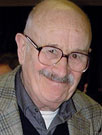A life unexamined
Designers shouldn’t be afraid to spend time thinking about a problem – interpretation and analysis lead to more efficient work methods, says David Bernstein

I’ve met some acute thinkers in the advertising and design industries, and remember all of them. Why? Because they made me think. That’s the thing about thinkers – they’re contagious. Though sometimes the contagion takes a while to show up. We all laughed. It was a good joke. It reinforced prejudices. But the more I thought about it, the more the phrase revealed an inner truth. For, unless we analyse the practice and articulate the principle which informs it, how do we learn, progress?
Ever eager to classify, we separate thinkers from doers, assuming the two activities, mental and practical, cannot coexist in the same person. Introducing a recent conference on corporate design at Strathclyde University, the principal of the business school defined an academic as ‘someone who sees something working in practice and wonders if it will work in theory’.
We all laughed. It was a good joke. It reinforced prejudices. But the more I thought about it, the more the phrase revealed an inner truth. For, unless we analyse the practice and articulate the principle which informs it, how do we learn, progress?
London Business School visiting professor Charles Handy, in his book The Age of Unreason, regards learning as a wheel divided into four parts. He calls it ‘life’s spiral treadmill’ because the wheel keeps on turning, at least for those who wish it to turn. It starts with a question, a problem to be solved. The next part is the theory, the possible answer. There follows the test – how well does it hold up? – and finally, reflection, during which the thinker asks why, why does it work?
I was intrigued to find that Handy’s experience, thoughbroader, echoed mine. Ask a chief executive to explain his philosophy and, invariably, ‘he will tell you what he did rather than what he learned’. He (and I’ll stay with the male pronoun) may also express a disdain for theories, even his own. Heaven forbid that he should be thought of as an academic!
Why, in this era of ‘lifelong learning’ should ‘academic’ have become a pejorative term? Is a need to understand interpreted as an admission of some inadequacy in one’s knowledge? Is it demeaning to be found at the end of the day completing a self-imposed questionnaire headed ‘What have I learned from what I’ve been doing?’
Are creative people any more interested in theories? I doubt it. Whenever I chose to ask an art director or copywriter how the ad they were jointly devising was expected to work (for example, what target response it was meant to provoke) I was usually met with a wall of incomprehension. As for eliciting from either of them a model of their communication process, don’t hold your breath.
One wonders (a) whether either could construct a meaningful model, and (b) if their separate models would correspond. But consider – if marketing communication is to be taken seriously, shouldn’t that team’s immediate superiors and the client
expect that the couple are working along the same lines, according to some basic and mutually held principles? In real professions, like medicine, for example, such an expectation is taken for granted.
At any time of the day or night, thinkers are never far away from the three ‘Ps’ – pen, paper and problem. The last may be a current project or a problem of their own devising. The thinkers I’ve known are eternally curious, asking why and why not, questioning assumptions, including their own, revisiting old questions and creatively reframing them. They are restless: so they need something to occupy them in the middle of the night. What better than Handy’s treadmill?
-
Post a comment




